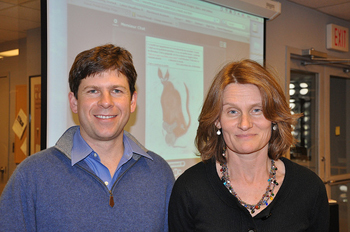FREN 205
 Taught by: Tom Parker and Susan Hiner
Taught by: Tom Parker and Susan Hiner
The Course
What is the course in which you use instructional technologies about? Tell us about its origin, goals and objectives.
Our goal in French 205 is to teach basic language proficiency through authentic cultural materials. In this case, we used French children’s literature to provide students a nuanced understanding of the target language/culture. Our pedagogical process attempted to mirror that of a native French-speaking child living, learning the language and the culture. Our hope was that students would respond positively to an approach that avoided the daunting grammar boot-camp system that can make language learning at this level a repugnant activity for some.
By organizing Intermediate French 1 (French 205) around children’s literature, play, and performance we try to engage students better in the language and liberate them from the experience of language acquisition as fear-based. Our aims in this project are twofold: (1) to encourage students to enter the role of the child, which corresponds to their “linguistic age” in the target language, without infantilizing them, thus allowing them to experience language as a natural and evolving process, giving them a concrete cultural experience, so that they may overcome their inhibitions about making mistakes and suspend their critical faculty in order to inhabit the role; and (2) to encourage them in a second move to experience language learning meta-critically, to feel and live the acculturation process and to examine critically that process, thinking about the production and meaning of French and Francophone culture itself.
The course idea originated in discussions with other FL professors about language pedagogy, content-based teaching, and task-based methods and it was funded at the beginning by a grant from the Carolyn Grant Endowment supporting “embodied learning.”
The Technology
What were the technologies used and how did they change or enhance your course?
We scanned and uploaded children’s books to Blackboard. Students were able to read these authentic cultural materials on the secure Blackboard site. We projected these books in class and developed a variety of language and culture-oriented activities based on the books. We used computer tablets to allow collective activities in which students filled in grammar exercises together pertaining to the reading and commented on the stories directly. We are looking forward to using a SmartBoard the next time we teach the course, which will enable us not only to project the books, but also to write on them (virtually), manipulating grammatical structures and building vocabulary.
For the final project we used a program called Voicethread that allows users to comment on images and video on-line. Students wrote and illustrated their own children’s book, building on the grammar and developing themes they had worked with throughout the semester. The students shared their books with the rest of the class, which were not only illustrated by the individual groups, but also narrated in French thanks to the recording feature of the Voicethread program. Using the editing feature on Voicethread, it is possible for us to mark up the copy either verbally or with annotations to make comments on themes and correct grammar. Students as well could have used the technology in the same way, either to help each other with language problems, or initiate a video-recorded dialogue in French regarding the themes in question.
The Student Response
How have your students responded to your use of this technology?
Students reacted in a very positive way to Voicethread, and had no problem adapting and integrating the technology. They produced some remarkable books—integrating the four traditional language skills in their final product: reading, listening, speaking, and writing and adding the elements of creativity and play that were the hallmarks of our methodology.
Regarding the PC Tablet technology, it was somewhat laborious to pass the laptop around to members of the class, and we are not sure that the class concluded that the pedagogical payoff adequately compensated for the time and effort it took to circulate the laptop to 25 different people. When we controlled the Tablet ourselves, however, and used it to project documents for editing or oral questioning about a text, it worked beautifully.
The Challenges
What were the challenges you faced when teaching this course?
The problems we encountered were related to equipment reliability and service rather than the technology itself. For example, the Tablet technology was a vast improvement to using a blackboard, but it was very hard to count on there being a fast, hassle-free interface in the rooms where we were using the technology. We soon learned also that we could not completely bank on the technology to work as we prepared the class, since classroom equipment is shared by many and is not always reliable. Voicethread proved a challenge when students presented their final projects because loading the pages took time on the server and, in a couple of instances, the recordings simply refused to load and play (again, high server volume seems to have caused this). Students were thus forced to read aloud the stories to the class as others looked on to the projected image. This was a shame because certain sound effects that were a part of the initial preparation were lost.
New Directions
What new directions would you like to explore with technology in your teaching?
Time prevented us from using the final project to the extent that we might have for additional pedagogical purposes. In the future, we would like to maximize the potential of the student projects for grammar work in conjunction with a further creative development in the target language. Ideally, we would integrate Voicethread technology in a SmartBoard application to encourage group activities where the entire class could easily benefit.
